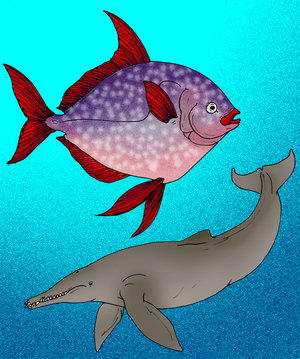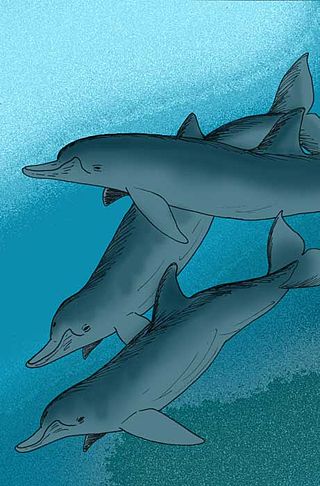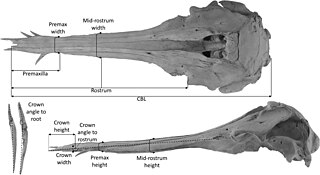
Prosqualodon is an extinct genus of Early to Middle Miocene cetacean from Argentina, Australia, New Zealand and Venezuela.
Mammalodon is an extinct genus of archaic baleen whale belonging to the family Mammalodontidae.

Waipatia is an extinct genus of odontocetes from the late Oligocene (Chattian) of New Zealand.

Alexandronectes is a genus of elasmosaurid plesiosaur, a type of long-necked marine reptile, that lived in the oceans of Late Cretaceous New Zealand. It contains one species, A. zealandiensis. Fossils of Alexandronectes were found in the Conway Formation of Canterbury, which can be dated to the Early Maastrichtian stage of the Cretaceous. Fossils of it were found around 1872 near the Waipara River, north of Christchurch, New Zealand.

Australodelphis mirus is an extinct Pliocene dolphin. A. mirus is known from fossils found in the Sørsdal Formation, Mule Peninsula, Vestfold Hills, East Antarctica. The genus has been described as an example of convergent evolution with beaked whales.

Kentriodontidae is an extinct family of odontocete whales related to modern dolphins. The Kentriodontidae lived from the Oligocene to the Pliocene before going extinct.

Waipatiidae is an extinct family of odontocetes currently known from the Oligocene of the Pacific Ocean and possibly Europe and the Caucasus.

Kairuku is an extinct genus of penguin. It contains three species, K. grebneffi, K. waitaki and K. waewaeroa. This taxon is known from bones from 27 MYA, from the Kokoamu Greensand Formation of New Zealand. It was historically referred to as Palaeeudyptes.
Duntroonornis parvus, also referred to as the Duntroon penguin, is a genus and species of extinct penguin from the Late Oligocene of New Zealand. The penguin was relatively small, similar in size to the Fiordland crested penguin. It was described by Brian Marples in 1952 from fossil material collected near Duntroon, from the Kokoamu Greensand Formation, near the border between the Canterbury and Otago regions of the South Island. Fossils found at the Hakataramea Valley may also be referrable to this species. The genus name Duntroonornis means "Duntroon bird". The specific epithet is the Latin parvus ("small").

The Pysht Formation is a geologic formation in Washington (state). It preserves fossils dating back to the Paleogene period, which appear to have been deposited in an offshore marine environment. Outcrops are present on the northern Olympic Peninsula, in Clallam County.

Otekaikea is an extinct genus of toothed whale closely related to Waipatia. It is known from the late Oligocene (Chattian) of New Zealand.
Tohoraata is a genus of eomysticetid baleen whale from the Late Oligocene (Chattian) of New Zealand. There are two recognized species, T. raekohao and T. waitakiensis.
Eomysticetidae is a family of extinct mysticetes belonging to Chaeomysticeti. It is one of two families in the basal chaeomysticete clade Eomysticetoidea.
Microcetus is a genus of extinct odontocete from the late Oligocene (Chattian) of Nordrhein-Westfalen, Germany.
Matapanui is a genus of eomysticetid baleen whale from the Late Oligocene Kokoamu Greensand of New Zealand.

Horopeta is a genus of baleen whale from the Late Oligocene (Chattian) Kokoamu Greensand of New Zealand.

Kekenodon is an extinct kekenodontid early whale from the Late Oligocene (Chattian) of New Zealand. Measuring 8–9 m (26–30 ft) long, it was a large raptorial whale which hunted marine mammals and penguins. Although at times classified as a basilosaurid, mysticete, or odontocete, recent work suggests that it represents a phylogenetic intermediate form between Basilosauridae and Neoceti.

Tangaroasaurus is an extinct genus of squalodontid whale from the Miocene of New Zealand. It contains a single species, Tangaroasaurus kakanuiensis. Similar to Basilosaurus and its close relative Squalodon, it was originally thought to be a species of marine reptile. Parts of the Holotype are presumably lost. Its name comes from Tangaroa, the Māori god of the sea, while the suffix -saurus comes from the Latin word for reptile, the group that Tangaroasaurus was originally placed in.

Nihoroa is an extinct genus of waipatiid odontocete cetacean from the glauconitic Otekaike Limestone in North Otago; New Zealand. The type species is N. reimaea, known from only the holotype which comprises various skull elements.













